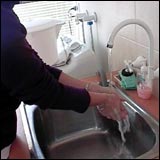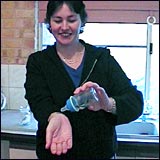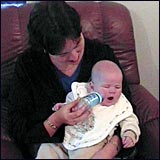Behaviour
Caring for babies
Bottle feeding
Changing a nappy
Cleaning and sterilising bottles
Daily cleaning tasks
Helping new children settle in
Preparing for a nappy change
Sleep patterns – babies
Sleep routines – babies
Toilet training
Caring for children
Allowing time for practice
Dressing/undressing
Mealtimes
Nappy change
Packing away/caring for the environment
Sleep/rest time
Toileting
Common self-help milestones
Tips for sleep and rest time
Self image
Communication
Body language
Limits and guidelines
Ways children communicate
Greeting children and families
Modelling appropriate communication
Questioning
Verbal and non–verbal communication
Acknowledging children's feelings
Listening attentively
Communicating with Aboriginal and Torres Strait Islander parents/carers
Development
Allowing time for practice
Dressing/undressing
Mealtimes
Nappy change
Packing away/caring for the environment
Sleep/rest time
Toileting
Common self-help milestones
Creative development
Language development
Modelling positive relationships
Physical development
Sharing and taking turns
Sleep patterns – babies
Sleep routines – babies
Encourage independent problem solving
Fundamental movement skills
Health, hygiene and safety
Coping with stress
Correct manual handling principles
Daily cleaning tasks
Hand washing
Hand washing poster
Manual handling overview
Toilet training
Safety checklist
Learning experiences and play
Environmentally friendly learning experiences
Learning experiences for different development areas
Creative resource materials
Arranging the environment to facilitate learning and pleasure
Indoors and outdoor areas
Creating a positive physical environment
Legal and ethical issues
Child abuse case studies
How do I recognise when a child or young person is at risk?
Tips on dealing with disclosures
Observation methods
Arranging Experiences (PDF 351Kb)
Recording observations
Rules for making observations
What you can learn from observations
Programming
Children’s interests, strengths, needs and skills
Extending the children’s interest in dinosaurs
Objective observation
Planning an OSHC environment
Behavior management plan
Planning enjoyable experiences
Planning experiences for 0 - 2 years age group
Planning experiences for 2 - 3 years age group
Planning experiences for 3 - 5 years age group
Bottle feeding
Feeding a baby can be a very special time. It is an opportunity to build on your relationship with the baby and spend some one-on-one time. As a caregiver, this may not always be possible, as you have other children to care for. You will need to learn the skill of nursing the baby while communicating with the other children at the same time.
Have a look at the procedure for bottle feeding below.

Before you begin feeding you need to make sure that both you and the baby are clean and ready to relax while feeding.

Wash and dry your hands thoroughly.

Make sure that the front of your clothing where the baby’s head will be resting is clean. You could use a clean apron if you needed to cover your clothes. Make sure that the baby is clean and comfortable. It is best for them to have a clean nappy if needed.

Wash the baby’s hands and face before you begin. This helps to build a routine of good hygiene. Changing the baby’s nappy and cleaning their face and hands also means that the baby is prepared for bed if they happen to nod off to sleep during feeding.

Before you give the baby their bottle, shake the bottle to make sure that all the milk is at a constant heat. Test the temperature of the milk to make sure it is not too hot or cold by squirting some milk onto your wrist.

Keep the bottle at an appropriate angle during feeding so that the teat of the bottle is always full of milk, to prevent the baby drinking in air bubbles. Have breaks during feeding if the baby needs it. Halfway through feeding, change the side that you are feeding on.

Only feed a baby until they have had enough. Never force feed the baby. They have small stomachs and will only eat until they are full.